Pat Mora's Blog, page 69
May 25, 2012
Creativity Salon: an Interview with Dr. Janice Gould
I’ll begin the post by saying: Welcome to my Bookjoy Creativity Salon Janice, and congratulations on recently receiving tenure at the University of Colorado, Colorado Springs. You are a new friend with whom I’ve so enjoyed spending time recently.
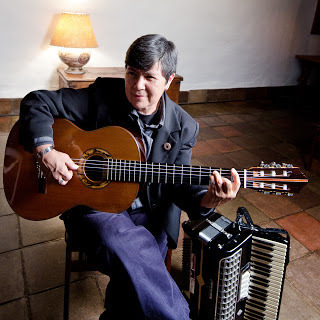 Photo by credit Jason Ordaz, School for Advanced Research, Santa Fe, NM
1. You’re a poet, scholar, teacher, musician, photographer, a woman creative in so many ways. When and how did your awareness of your creativity begin?
Photo by credit Jason Ordaz, School for Advanced Research, Santa Fe, NM
1. You’re a poet, scholar, teacher, musician, photographer, a woman creative in so many ways. When and how did your awareness of your creativity begin?
JG: My mother encouraged my sisters and me to be creative when we were just little. She gave us lots of room to explore our world and to play. We made up stories and acted them out: we were pioneers, cowboys, Indians, detectives, railroad engineers, wanderers and explorers. I liked to draw and color; my mom was always enthusiastic about my work. She taught us music—we had a piano—and we were always singing. In first grade, I wrote a poem about the rain, and doing this I realized all in a flash how I felt about rain, how I perceived it.
Writing that little poem provided me with an opportunity to gain insight into how I connect with the natural world. I had found a new way to see things and it felt exciting and marvelous.
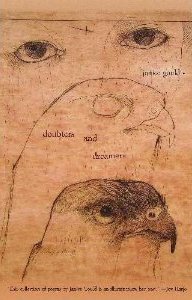 2. Thinking back to yourself in third grade, are you surprised at what you are doing now, at the woman you have become?
2. Thinking back to yourself in third grade, are you surprised at what you are doing now, at the woman you have become?
JG: When I was in third grade, I had a teacher who segregated our class, putting all the “dark” children together, and treating us one way, and placing all the white children together and treating them another way—giving them certain privileges, and treating us “dark” children as if we were too “dumb” to protest this. Back in those days, we learned folk dancing as part of our curriculum. The teacher didn’t want the white children to partner with the “dark” children.
My mother had talked with my sisters and me about discrimination based on race, something she had faced as a young person (and as an adult). It seemed wrong to me that the teacher had separated us children into distinct groups. I went home and complained about this to my parents. The sense of social justice and injustice my mom instilled in us still resides in me.
I was also sure from an early age that I wanted to be an artist. I loved drawing, enjoyed making music, and as a teenager began exploring poetry. I studied oboe, and when I started college, I majored in music. But because I liked to read and write, and because I was rebellious in my own way, I eventually followed the path of poetry.
After I realized that I was a lesbian (I was a teenager, and this was an era when people did not talk about sexuality or sexual orientation), I felt that there was no place where I could be naturally and truthfully myself. It was a very difficult time, and it took years before I felt comfortable being “open” about my sexual preference. As feminism emerged on the scene, making it possible for girls and women to dream and imagine different possibilities for themselves, the world opened up in new ways. I found I could live truthfully.
3. Family and nature seem deep sources of inspiration for your poetry, yes? Are they also sources for your other creative work?
JG: While family and the natural world are to be sources for my writing, it is the idea of relationship that motivates and inspires me. As a photographer—and I am an amateur at this practice—I love recording the natural world. I respond affectionately to “landscape” in my photographic work and also with my music.
Friendship and love are equally inspiring sources for writing. Perhaps inwardly (and against all reason), I am always fearful that love will withdraw, leaving me bereft, lacerated, and in a kind of despair. The power of that withdrawal is frightening to me. I have always pursued intense friendships and sought intensity in lovers. And like many artists and others, I desire praise; it helps feed creativity. “Am I connecting with you?” is my unspoken question.
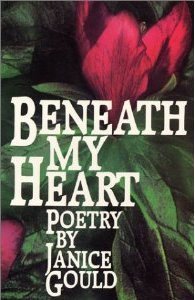
4. Are your varied creative expressions connected?
JG: Yes, but I’m not entirely sure how. Music and poetry have much in common: sound, rhythm, and tone. My poetry tends to be lyrical—I sometimes use more formal structures to express an idea, though I also employ free verse. My work is also narrative. My impulse, again, is to connect with others through emotional knowledge, through the body’s knowledge.
I’m still learning how to take photographs. I notice in professional photography uses of lighting or coloring that ask me to look deeper, to observe the surface and also what lies below the surface, what emerges from another layer. I am drawn to work that is generous, inclusive, and affectionate, that helps us connect with the beautiful and fecund world.
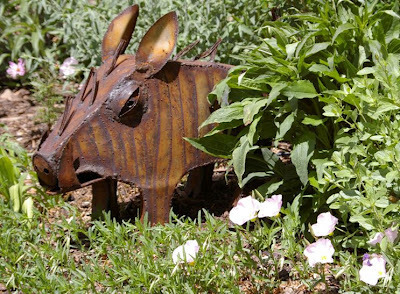

5. You have studied and been inspired by the grand Spanish poet Federico García Lorca. What fascinates you about his voice on the page?
JG: Lorca seemed aware of the power that brings both life and death. He called it “duende,” a term that we associate with flamenco, with the movements and rhythms of dance, theater, and performance. In his famous essay on this subject, Lorca disposed of the muse and the angel, forces that worked for earlier generations of writers—those given to nostalgia or pure intellectualism. He wanted to tap into a stronger impulse, something that came right up out of the earth and entered the body, tearing away masks and pretences, useless language, politeness, effeteness. He wanted to connect with something that felt more raw, “primitive,” and truthful. For him, it seems, truth could be found in the magic of the natural world: in wind, shadow, snow, and water; in the various acids that eat away at surface; in death and decay.
While Lorca’s imagination could explore violence, he tempered violence with language, always aware of the sounds of lamentation, loneliness, and longing. As a homosexual living under the repressive order of that day and time, he probably experienced life as a surface, for when people cannot live openly, they must resort to secrecy and deceptions—ways to carry on their own natural impulses inwardly when the reality of the surface prohibits and disdains them. I believe that Lorca imagined the stultification and sterility of Spanish conservatism through a feminine reality (for example in his plays) because it was clear to him that women suffered from sexual and political repression. Yet Lorca’s voice seldom feels “political,” and never didactic. His approach was to encourage human connection through lyricism—song and music were important to him—and imagination, through a magical, sometimes whimsical, sometimes violent apprehension of the natural world and the world of human making.
6. In your essay in the book you co-edited, Speak to Me Words: Essays on Contemporary American Indian Poetry, you write, “We have to forgive our imperfections and heal the hole in our hearts that is left there by shame.” The book was published in 2003. What have you learned in the intervening years about the connection between creative work and healing ourselves?
 JG: Healing is creative when it comprises a re-creation of self, the work of the psyche, the soul. As I think about my own inner work, I realize I have become clearer about what I want to do, and as importantly, what I do not wish to do. I have learned to say “no” to certain tasks that would take psychic time and energy away from writing poetry or music. Creative work is healing when it’s undertaken without guilt, when we move past the distractions that life presents. If we believe our job is to give back through our creative works, we must sometimes be “selfish” to accomplish this.
JG: Healing is creative when it comprises a re-creation of self, the work of the psyche, the soul. As I think about my own inner work, I realize I have become clearer about what I want to do, and as importantly, what I do not wish to do. I have learned to say “no” to certain tasks that would take psychic time and energy away from writing poetry or music. Creative work is healing when it’s undertaken without guilt, when we move past the distractions that life presents. If we believe our job is to give back through our creative works, we must sometimes be “selfish” to accomplish this.
7. Any new projects you’d like to share with us?
JG: I’ve been working on a new manuscript of poems since 2009. I have several “gacelas” (a term I borrow from García Lorca), some lyric poems in free verse, and some that I term “prose poems.” I post some of my photos to my blog. And I continue to practice guitar and to write music for it and for accordion.
8. What makes Janice really laugh?
JG: I saw Marcel Marceau in performance once. He made me laugh because Bip was most always in a daydream, which meant that whatever he was trying to accomplish came with goofy mistakes (having to re-button his shirt many times, tripping over his own feet, trying to look nonchalant, even debonair, but slipping on a banana peel at the last moment). Bip had a sweetness and innocence that came from having an affectionate heart, a heart that took in all the world and gave it all back with the largest of grins, voicelessly.
Although Marceau has passed on, I still love Bip’s humanity and relate to his penchant for error. I enjoy being in the company of people who act from the heart, who are not afraid of silliness, who laugh with soft laughter.
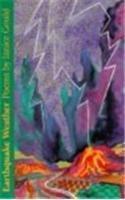 Read Janice's blog and see more photographs.
Read Janice's blog and see more photographs.
 Photo by credit Jason Ordaz, School for Advanced Research, Santa Fe, NM
1. You’re a poet, scholar, teacher, musician, photographer, a woman creative in so many ways. When and how did your awareness of your creativity begin?
Photo by credit Jason Ordaz, School for Advanced Research, Santa Fe, NM
1. You’re a poet, scholar, teacher, musician, photographer, a woman creative in so many ways. When and how did your awareness of your creativity begin?
JG: My mother encouraged my sisters and me to be creative when we were just little. She gave us lots of room to explore our world and to play. We made up stories and acted them out: we were pioneers, cowboys, Indians, detectives, railroad engineers, wanderers and explorers. I liked to draw and color; my mom was always enthusiastic about my work. She taught us music—we had a piano—and we were always singing. In first grade, I wrote a poem about the rain, and doing this I realized all in a flash how I felt about rain, how I perceived it.
Writing that little poem provided me with an opportunity to gain insight into how I connect with the natural world. I had found a new way to see things and it felt exciting and marvelous.
 2. Thinking back to yourself in third grade, are you surprised at what you are doing now, at the woman you have become?
2. Thinking back to yourself in third grade, are you surprised at what you are doing now, at the woman you have become?
JG: When I was in third grade, I had a teacher who segregated our class, putting all the “dark” children together, and treating us one way, and placing all the white children together and treating them another way—giving them certain privileges, and treating us “dark” children as if we were too “dumb” to protest this. Back in those days, we learned folk dancing as part of our curriculum. The teacher didn’t want the white children to partner with the “dark” children.
My mother had talked with my sisters and me about discrimination based on race, something she had faced as a young person (and as an adult). It seemed wrong to me that the teacher had separated us children into distinct groups. I went home and complained about this to my parents. The sense of social justice and injustice my mom instilled in us still resides in me.
I was also sure from an early age that I wanted to be an artist. I loved drawing, enjoyed making music, and as a teenager began exploring poetry. I studied oboe, and when I started college, I majored in music. But because I liked to read and write, and because I was rebellious in my own way, I eventually followed the path of poetry.
After I realized that I was a lesbian (I was a teenager, and this was an era when people did not talk about sexuality or sexual orientation), I felt that there was no place where I could be naturally and truthfully myself. It was a very difficult time, and it took years before I felt comfortable being “open” about my sexual preference. As feminism emerged on the scene, making it possible for girls and women to dream and imagine different possibilities for themselves, the world opened up in new ways. I found I could live truthfully.
3. Family and nature seem deep sources of inspiration for your poetry, yes? Are they also sources for your other creative work?
JG: While family and the natural world are to be sources for my writing, it is the idea of relationship that motivates and inspires me. As a photographer—and I am an amateur at this practice—I love recording the natural world. I respond affectionately to “landscape” in my photographic work and also with my music.
Friendship and love are equally inspiring sources for writing. Perhaps inwardly (and against all reason), I am always fearful that love will withdraw, leaving me bereft, lacerated, and in a kind of despair. The power of that withdrawal is frightening to me. I have always pursued intense friendships and sought intensity in lovers. And like many artists and others, I desire praise; it helps feed creativity. “Am I connecting with you?” is my unspoken question.

4. Are your varied creative expressions connected?
JG: Yes, but I’m not entirely sure how. Music and poetry have much in common: sound, rhythm, and tone. My poetry tends to be lyrical—I sometimes use more formal structures to express an idea, though I also employ free verse. My work is also narrative. My impulse, again, is to connect with others through emotional knowledge, through the body’s knowledge.
I’m still learning how to take photographs. I notice in professional photography uses of lighting or coloring that ask me to look deeper, to observe the surface and also what lies below the surface, what emerges from another layer. I am drawn to work that is generous, inclusive, and affectionate, that helps us connect with the beautiful and fecund world.


5. You have studied and been inspired by the grand Spanish poet Federico García Lorca. What fascinates you about his voice on the page?
JG: Lorca seemed aware of the power that brings both life and death. He called it “duende,” a term that we associate with flamenco, with the movements and rhythms of dance, theater, and performance. In his famous essay on this subject, Lorca disposed of the muse and the angel, forces that worked for earlier generations of writers—those given to nostalgia or pure intellectualism. He wanted to tap into a stronger impulse, something that came right up out of the earth and entered the body, tearing away masks and pretences, useless language, politeness, effeteness. He wanted to connect with something that felt more raw, “primitive,” and truthful. For him, it seems, truth could be found in the magic of the natural world: in wind, shadow, snow, and water; in the various acids that eat away at surface; in death and decay.
While Lorca’s imagination could explore violence, he tempered violence with language, always aware of the sounds of lamentation, loneliness, and longing. As a homosexual living under the repressive order of that day and time, he probably experienced life as a surface, for when people cannot live openly, they must resort to secrecy and deceptions—ways to carry on their own natural impulses inwardly when the reality of the surface prohibits and disdains them. I believe that Lorca imagined the stultification and sterility of Spanish conservatism through a feminine reality (for example in his plays) because it was clear to him that women suffered from sexual and political repression. Yet Lorca’s voice seldom feels “political,” and never didactic. His approach was to encourage human connection through lyricism—song and music were important to him—and imagination, through a magical, sometimes whimsical, sometimes violent apprehension of the natural world and the world of human making.
6. In your essay in the book you co-edited, Speak to Me Words: Essays on Contemporary American Indian Poetry, you write, “We have to forgive our imperfections and heal the hole in our hearts that is left there by shame.” The book was published in 2003. What have you learned in the intervening years about the connection between creative work and healing ourselves?
 JG: Healing is creative when it comprises a re-creation of self, the work of the psyche, the soul. As I think about my own inner work, I realize I have become clearer about what I want to do, and as importantly, what I do not wish to do. I have learned to say “no” to certain tasks that would take psychic time and energy away from writing poetry or music. Creative work is healing when it’s undertaken without guilt, when we move past the distractions that life presents. If we believe our job is to give back through our creative works, we must sometimes be “selfish” to accomplish this.
JG: Healing is creative when it comprises a re-creation of self, the work of the psyche, the soul. As I think about my own inner work, I realize I have become clearer about what I want to do, and as importantly, what I do not wish to do. I have learned to say “no” to certain tasks that would take psychic time and energy away from writing poetry or music. Creative work is healing when it’s undertaken without guilt, when we move past the distractions that life presents. If we believe our job is to give back through our creative works, we must sometimes be “selfish” to accomplish this.7. Any new projects you’d like to share with us?
JG: I’ve been working on a new manuscript of poems since 2009. I have several “gacelas” (a term I borrow from García Lorca), some lyric poems in free verse, and some that I term “prose poems.” I post some of my photos to my blog. And I continue to practice guitar and to write music for it and for accordion.
8. What makes Janice really laugh?
JG: I saw Marcel Marceau in performance once. He made me laugh because Bip was most always in a daydream, which meant that whatever he was trying to accomplish came with goofy mistakes (having to re-button his shirt many times, tripping over his own feet, trying to look nonchalant, even debonair, but slipping on a banana peel at the last moment). Bip had a sweetness and innocence that came from having an affectionate heart, a heart that took in all the world and gave it all back with the largest of grins, voicelessly.
Although Marceau has passed on, I still love Bip’s humanity and relate to his penchant for error. I enjoy being in the company of people who act from the heart, who are not afraid of silliness, who laugh with soft laughter.
 Read Janice's blog and see more photographs.
Read Janice's blog and see more photographs.
Published on May 25, 2012 06:26
May 22, 2012
Teacher Appreciation
 Colorín Colorado shared several videos about appreciating teachers, including my poem, "Ode to Teachers." In addition, individuals such as Dr. Thelma Meléndez, Rafael López, and Kristina Robertson share their own memories of special teachers who had an impact on their lives.
Colorín Colorado shared several videos about appreciating teachers, including my poem, "Ode to Teachers." In addition, individuals such as Dr. Thelma Meléndez, Rafael López, and Kristina Robertson share their own memories of special teachers who had an impact on their lives.(Image from Colorín Colorado.)
Published on May 22, 2012 16:31
May 17, 2012
Día at Bookmobiles
I was so pleased to donate books and posters to the New Mexico State Library for their Día celebration at bookmobiles. New Mexico is a rural state, and it's wonderful that bookmobiles serve children and families that don't have a nearby library. One of my grown daughters was reflecting recently how much she enjoyed visiting the bookmobile in El Paso.
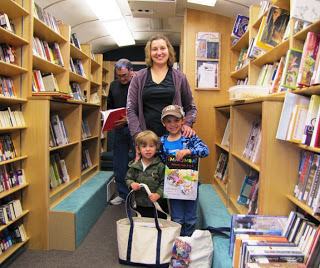 Wagon Mound, NM
Wagon Mound, NM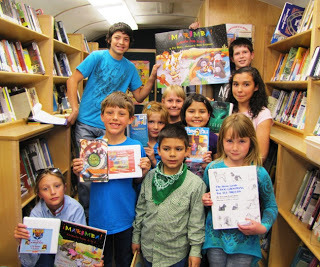 Mosquero School
Mosquero School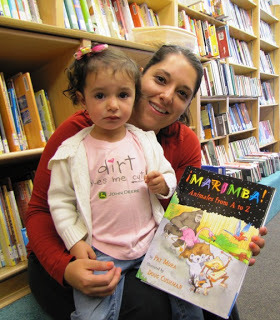 Mosquero, NM
Mosquero, NMPhotos courtesy of Rural Bookmobile Northeast/New Mexico State Library, a division of the Department of Cultural Affairs.
Published on May 17, 2012 10:24
May 8, 2012
Teacher Appreciation Day
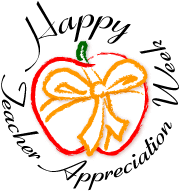
Congratulating dedicated teachers at all levels! Thanks for the vitality, the ZING you bring to your classrooms and libraries.
 Zing! Seven Creativity Practices for Educators and Students
Zing! Seven Creativity Practices for Educators and Students
Published on May 08, 2012 07:56
April 30, 2012
Happy Día!
 When we first started celebrating El día de los niños/El día de los libros, Children's Day/Book Day in 1996, we focused on April 30th, El Día del niño in Mexico, the observance that inspired me to promote celebrating children and linking that celebration to literacy. REFORMA (National Association to Promote Library and Information Services to Latinos and the Spanish-Speaking) was my first organizational partner in this work. Thanks to support from my friend Dr. Dan Moore who was then at the W.K. Kellogg Foundation, ALSC (Association of Library Service to Children) offered to become Día’s home in 2004. (See Día Visual History.)
When we first started celebrating El día de los niños/El día de los libros, Children's Day/Book Day in 1996, we focused on April 30th, El Día del niño in Mexico, the observance that inspired me to promote celebrating children and linking that celebration to literacy. REFORMA (National Association to Promote Library and Information Services to Latinos and the Spanish-Speaking) was my first organizational partner in this work. Thanks to support from my friend Dr. Dan Moore who was then at the W.K. Kellogg Foundation, ALSC (Association of Library Service to Children) offered to become Día’s home in 2004. (See Día Visual History.)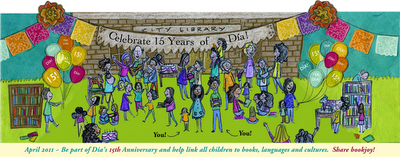
April, a month with many literary and literacy celebrations, now includes many Día celebrations throughout the month. I love the fact that Día is a community-based family literacy initiative and that schools and libraries select the specific date to have their book fiesta.
Soon we’ll begin thinking and planning for Día’s 17th anniversary in April 2013. Today, we celebrate a month of honoring children and exciting them about books, languages and cultures. Thanks to each of you who was part of a Día celebration this month, to USBBY (United States Board on Books for Young People) that has steadily supported Día, and to Albert Whitman & Co., Myrick Marketing & Media, and Tricycle Press. I had a wonderful time at Discovery Green in Houston last weekend, and on April 30th, I’ll be at Burnet and Kohlberg Elementary Schools in my home city of El Paso, Texas.
Special thanks to my web team Laurina Cashin & Bobbie Combs, to the new Día Author and Illustrator Ambassadors , REFORMA, ALSC and to the following partners listed on the ALSC Dia site: Arte Público, Charlesbridge Publishing, Cinco Punto Press, HarperCollins, Lee & Low Books, Lorito Books, Peachtree Publishers, Random House, NCTE (National Council of Teachers of English,) W.K. Kellogg Foundation.
Gracias! Thanks!
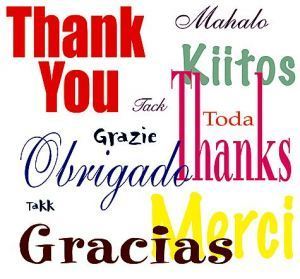
Published on April 30, 2012 05:38
April 29, 2012
El día de los niños/El día de los libros (Children’s Day/Book Day) in the News
 Recent news items about Día:
Recent news items about Día:“Día at Discovery – A Sweet 16 Celebration of Children’s Day, Book Day” (The Venture)
Writers in the Schools Students to Read with Pat Mora at Dia (Writers in the Schools blog)
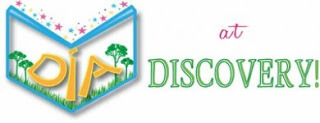
"Library Celebrating Childrens Day, Book Day" (Tulsa World)
Día de los Niños celebrated at all library branches (Daily Democrat)
UT/Austin Hispanic Faculty Staff Association organizes book collection for Día
Spring into Reading with Dia (Palm Springs Public Library blog (CA))
Latin Baby Book Club El día de los niños/El día de los libros Booklist (Latin Baby Book Club blog)
Thank you Día supporters!
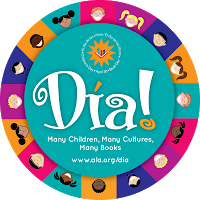
Published on April 29, 2012 05:53
April 27, 2012
Día Advocates A-Zing!
 I'm delighted to share an alphabet of twenty-six nouns that matter to all of us who work to connect all children to books, languages and cultures. I'm grateful to my Día partner Laurina Cashin who worked closely with our creative designer Desiree Rappa to create this poster for you to print and also share. May its sunny colors brighten your work space all year long. Also, may these words prove helpful when you share Día with future committees and with colleagues around the country. Yea for Día Advocates whose commitment and creativity always amaze me. Gracias!
I'm delighted to share an alphabet of twenty-six nouns that matter to all of us who work to connect all children to books, languages and cultures. I'm grateful to my Día partner Laurina Cashin who worked closely with our creative designer Desiree Rappa to create this poster for you to print and also share. May its sunny colors brighten your work space all year long. Also, may these words prove helpful when you share Día with future committees and with colleagues around the country. Yea for Día Advocates whose commitment and creativity always amaze me. Gracias!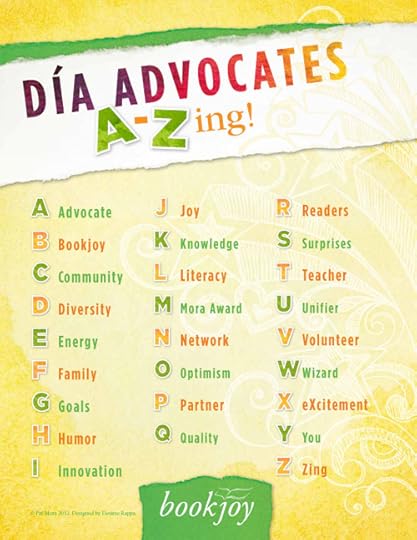
Download hi-res version for printing.
Download lo-res version for web use.
Published on April 27, 2012 04:22
April 26, 2012
Video Readings from Día Author and Illustrator Ambassadors
 Throughout this month's Díapalooza, we're featuring brief videos of some of the Día Author and Illustrator Ambassadors reading from their books. Today we have a double feature! First, author, storyteller and librarian Lucia Gonzalez, and next author and illustrator, Duncan Tonatiuh.
Throughout this month's Díapalooza, we're featuring brief videos of some of the Día Author and Illustrator Ambassadors reading from their books. Today we have a double feature! First, author, storyteller and librarian Lucia Gonzalez, and next author and illustrator, Duncan Tonatiuh.Lucia Gonzalez read her story The Bossy Gallito aloud at the Hollywood Branch of the Broward County Library System, on Saturday, April 21, 2012 during the "Children's Day, Book Day/El dia de los niños, el dia de los libros" Celebration.
Duncan reads from his award winning picture book Diego Rivera: His World and Ours.
Lucia and Duncan, thank you for your support of Día and for being a Día Author and Illustrator Ambassador!
Published on April 26, 2012 07:56
April 25, 2012
New Día Dynamo
 Dr. Jamie Cambell Naidoo, Assistant & Foster-EBSCO Endowed Professor,
Dr. Jamie Cambell Naidoo, Assistant & Foster-EBSCO Endowed Professor,School of Library & Information Studies, University of Alabama is our first Día Dynamo professor. It’s exciting to see a young academic, a staunch Día supporter, teaching through his example on his campus, in his community, and in his national professional organizations including ALA. Through his National Latino Children's Literature Conference, his work with Día Noche de Cuentos, and school and library events, he celebrates Latino cultural literacy. In person and on the page, Jamie inspires present and future librarians and teachers when he shares Día’s goals, rationale and potential. A prolific publisher and enthusiastic, engaging presenter across the country, Jamie has a knack for making Día irresistible, an obvious family literacy initiative for all. Gracias, Jamie!
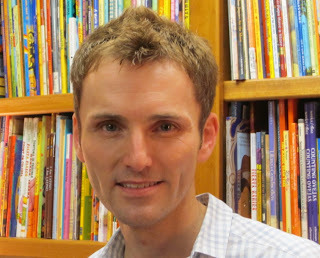
Here is a quote from Jamie about Dia:
"Día provides a catalyst for dynamic cultural literacy programming in classrooms and libraries, connecting readers of all ages to high-quality, authentic literature that mirrors our culturally pluralistic society."
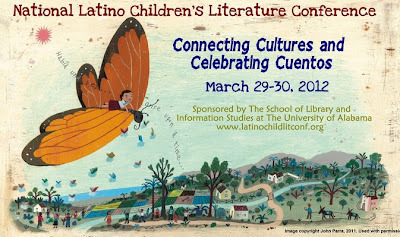
Jamie talks about this year's National Latino Children's Literature Conference:
"I believe in the power of Día to promote literacy and have incorporated it into my National Latino Children's Literature Conference, which is held biannually in March. Since the conference's inception in 2007, Día has been a perfect avenue for celebrating Latino cultural literacy and distributing high-quality Latino children's literature to children and their families via free Día community events in libraries and schools. In March 2012, I hosted a Noche de Cuentos celebration of Día at the Tuscaloosa Public Library where children and their families joined attendees from the National Latino Children's Literature Conference and 7 Latino authors and illustrators as we celebrated bookjoy! Each child received a free copy of The Tooth Fairy Meets El Ratón Pérez and each family received a free copy of ¡Muu, Moo!: Animal Nursery Rhymes. The authors of these books engaged the children in storytelling and signed copies of their books."
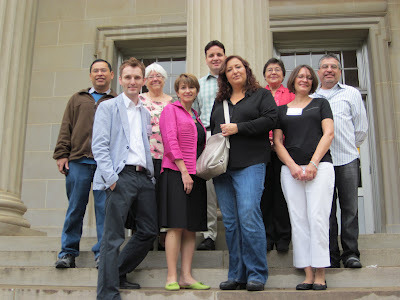 Authors & illustrators attending the 2012 NLCLC
Authors & illustrators attending the 2012 NLCLC Back L to R: René Colato Laínez, Alma Flor Ada, John Parra, Joe Cepeda
Front L to R: Jamie Naidoo, Lila Quintero Weaver, Monica Brown, Meg Medina
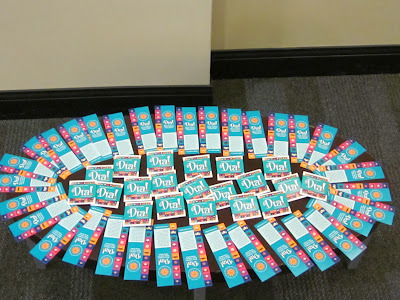 A Dia flower
A Dia flowerSee all Día Dynamos on Pat's website.
Published on April 25, 2012 04:55
April 24, 2012
Día Reflections
 Last year, to celebrate Día's 15th Anniversary, my web team and I created a down-loadable booklet,
Pat Mora's Idea Booklet for a Día Year
, DÍA as in Delight in celebrating children, Imagine your community strengthened by reading families, Affirm the importance of daily sharing bookjoy. We hope you have found the booklet a useful tool with your planning committee. We hope to continue adding to these ideas and welcome your suggestions.
Last year, to celebrate Día's 15th Anniversary, my web team and I created a down-loadable booklet,
Pat Mora's Idea Booklet for a Día Year
, DÍA as in Delight in celebrating children, Imagine your community strengthened by reading families, Affirm the importance of daily sharing bookjoy. We hope you have found the booklet a useful tool with your planning committee. We hope to continue adding to these ideas and welcome your suggestions.I also wrote 30 Reflections since I believe that to be our most effective in our advocacy work, we need to regularly move between reflection and action, reflection and action, so that we invest our energy in our highest priorities and thus act wisely. Last year, I began the reflections by saying that "day by day, día por día, I invite each of us to read the reflection and then to ponder: how am I doing this in my own life?" I hope you find these thoughts helpful.
Through Día, share bookjoy!

Let’s see ourselves as part of the National Día Community connected by our commitment to the potential of each child and to the pleasure and power of literacy.
Let’s create regular time to reflect on the importance, challenges and opportunities of Día’s goals.
Let’s remind one another often that Día is a daily commitment and not only an annual celebration.
Let’s creatively make Día fun for ourselves and others.
Let’s champion children and literacy in our daily lives and creatively and concretely introduce Día to potential partners.
Let’s learn what other Día advocates have shared and discovered.
Let’s affirm home languages and diverse cultures.
Let’s learn together to be more compelling in articulating the importance and relevance of our goals to our various communities.
Let’s explore new ways to share what we’ve learned or are trying to implement.
Let’s reach out to new partners including elected officials, school administrators and faculty preparing future librarians and teachers.
Let’s attend and support an annual Día celebration and experience the joy of honoring children and of linking children and families to books.
Let’s question our assumptions about how to reach our goals and who our appropriate partners can be.
Let’s thank and celebrate our partners again and again.
Let’s create Día planning communities locally and nationally that reflect the diversity we espouse, and let’s invite social service agencies, the media, the young and seniors to enrich our work.
Let’s remember that effective advocates need to endure the challenges of learning new skills; in Día’s case: partnership building, fund raising, marketing, publicity, public speaking, social networking, true collaboration.
Let’s assist school and public libraries to diversify their collections to reflect our national diversity and global connections.
Let’s design Día programs and celebrations that—though they may include food, music, dancing and prizes—create positive and memorable literacy experiences for attendees.
Let’s encourage and assist all families to build home libraries, to celebrate Día annually at home, and to take pride in being reading families.
Let’s involve children as presenters in our various literacy events and at Día book fiestas and celebrate our children’s talents.
Let’s commit to developing programs that assist parents of our diverse families to become effective literacy mentors, our partners.
Let’s propose innovative solutions to predictable resistance to change and increase Día’s growth and impact.
Let’s praise leaders who become Día champions because they are committed to assisting all children to become learners.
Let’s remember that though change is slow, people and institutions can change; our challenge is to be persistent, effective advocates.
Let’s connect in committed circles that form the powerful community-based National Día Community in our city, state, region and country.
Let’s see ourselves as central rather than peripheral, as a force for positive change that welcomes ideas for expanding and deepening Día’s work.
Let’s collaborate: honor the perspectives we each bring, listen with open hearts and minds, respect our varying styles and unite for the well-being and future of our children, our nation’s future.
Let’s gather together when possible to re-excite one another about Día’s potential to enrich lives and strengthen families and communities.
Let’s rejoice that Día, this family literacy initiative that works to honor children and to connect them to books, languages and cultures, has grown for 15 years and continues to grow and flourish.
Let’s boldly plan together for Día’s 20th Anniversary expanding Día’s impact and thus uniting our too-often divided country, uniting for the well-being of all our children.
Let’s unite our energies, knowledge, and diverse skills, unleashing our creativity, adding our individual zing to sharing bookjoy and creating a nation of readers.
Published on April 24, 2012 06:00
Pat Mora's Blog
- Pat Mora's profile
- 96 followers
Pat Mora isn't a Goodreads Author
(yet),
but they
do have a blog,
so here are some recent posts imported from
their feed.



